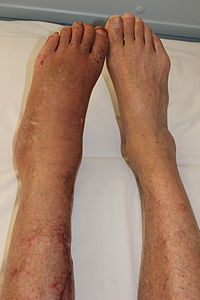
Photo from wikipedia
Objectives The primary aim was to study the prevalence of generalized joint hypermobility (GJH) among Thai physical therapy (PT) students. The secondary aims were to compare the lower limb alignments… Click to show full abstract
Objectives The primary aim was to study the prevalence of generalized joint hypermobility (GJH) among Thai physical therapy (PT) students. The secondary aims were to compare the lower limb alignments and lower limb joint pain and injury between GJH and non-GJH individuals. Furthermore, the association between GJH, lower limb alignment, and joint pain and injury were also evaluated. Material and methods Generalized joint hypermobility was assessed using the Beighton score with a cut-off of 4/9 in 255 PT students. The lower limb alignments measured in the study included pelvic tilt angle, tibiofemoral angle, quadriceps angle (QA), and navicular drop. Tibiofemoral angle and QA were measured with and without quadriceps contraction. The history of lower limb joint pain and injury was recorded with a simple questionnaire. Lastly, logistic regression analysis was used to study the association between GJH, lower limb alignment, and joint pain and injury. Results The prevalence of GJH was 21.18% among the studied population. Quadriceps angle during quadriceps relaxation of the non-dominant leg of the GJH group was the only lower limb alignment found greater than those of the non-GJH group. The rate of lower limb joint pain and injury was not different between the two groups. Furthermore, no significant association between GJH, lower limb alignment, and lower limb joint pain and injury was found. Conclusions GJH is not uncommon among Thai PT students. Only the non-dominant QA was found different between groups. Generalized joint hypermobility neither increase risk nor is it associated with lower limb joint pain and injury among Thai PT students.
Journal Title: Reumatologia
Year Published: 2022
Link to full text (if available)
Share on Social Media: Sign Up to like & get
recommendations!